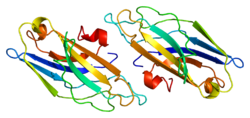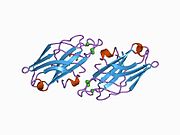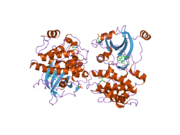In cell biology, Protein kinase C, commonly abbreviated to PKC (EC 2.7.11.13), is a family of protein kinase enzymes that are involved in controlling the function of other proteins through the phosphorylation of hydroxyl groups of serine and threonine amino acid residues on these proteins, or a member of this family. PKC enzymes in turn are activated by signals such as increases in the concentration of diacylglycerol (DAG) or calcium ions (Ca2+). Hence PKC enzymes play important roles in several signal transduction cascades.

Transforming growth factor beta receptor I is a membrane-bound TGF beta receptor protein of the TGF-beta receptor family for the TGF beta superfamily of signaling ligands. TGFBR1 is its human gene.

Protein kinase C delta type is an enzyme that in humans is encoded by the PRKCD gene.

Calcium/calmodulin-dependent protein kinase type II subunit alpha (CAMKIIα), a.k.a.Ca2+/calmodulin-dependent protein kinase II alpha, is one subunit of CamKII, a protein kinase (i.e., an enzyme which phosphorylates proteins) that in humans is encoded by the CAMK2A gene.

Dual specificity protein phosphatase 1 is an enzyme that in humans is encoded by the DUSP1 gene.

TNF receptor-associated factor 5 is a protein that in humans is encoded by the TRAF5 gene.
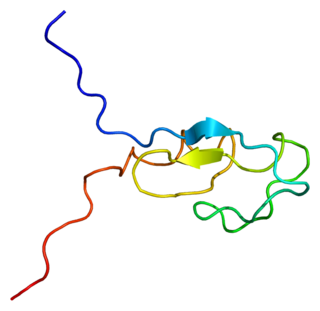
Protein kinase C gamma type is an enzyme that in humans is encoded by the PRKCG gene.

Receptor for activated C kinase 1 (RACK1), also known as guanine nucleotide-binding protein subunit beta-2-like 1 (GNB2L1), is a 35 kDa protein that in humans is encoded by the RACK1 gene.

Ribosomal protein S6 kinase alpha-1 is an enzyme that in humans is encoded by the RPS6KA1 gene.
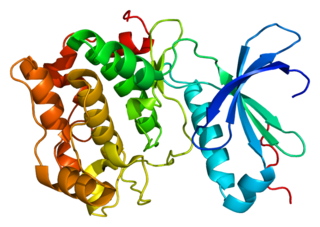
Protein kinase C theta (PKC-θ) is an enzyme that in humans is encoded by the PRKCQ gene. PKC-θ, a member of serine/threonine kinases, is mainly expressed in hematopoietic cells with high levels in platelets and T lymphocytes, where plays a role in signal transduction. Different subpopulations of T cells vary in their requirements of PKC-θ, therefore PKC-θ is considered as a potential target for inhibitors in the context of immunotherapy.

TNF receptor-associated factor (TRAF3) is a protein that in humans is encoded by the TRAF3 gene.

protein S6 kinase, 90kDa, polypeptide 3, also s RPS6KA3, is an enzyme that in humans is encoded by the RPS6KA3 gene.

Protein kinase C iota type is an enzyme that in humans is encoded by the PRKCI gene.

Protein kinase C eta type is an enzyme that in humans is encoded by the PRKCH gene.

G protein-coupled receptor kinase 5 is a member of the G protein-coupled receptor kinase subfamily of the Ser/Thr protein kinases, and is most highly similar to GRK4 and GRK6. The protein phosphorylates the activated forms of G protein-coupled receptors to regulate their signaling.

Phosphatidylinositol-4-phosphate 3-kinase C2 domain-containing beta polypeptide is an enzyme that in humans is encoded by the PIK3C2B gene.

Dual specificity mitogen-activated protein kinase kinase 5 is an enzyme that in humans is encoded by the MAP2K5 gene.

Beta-chimaerin is a protein that in humans is encoded by the CHN2 gene.

Serine/threonine-protein kinase D2 or PKD2 is an enzyme that in humans is encoded by the PRKD2 gene.

cGMP-dependent protein kinase 1, alpha isozyme is an enzyme that in humans is encoded by the PRKG1 gene.
